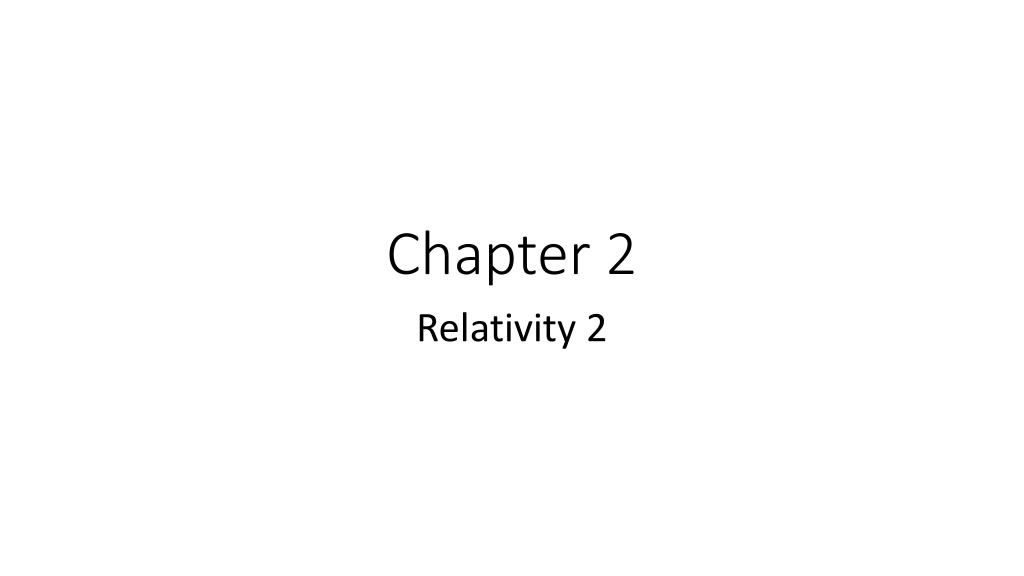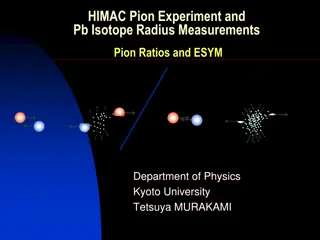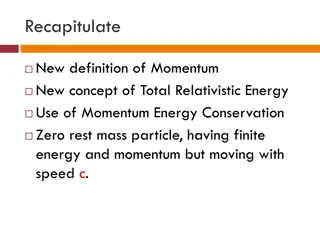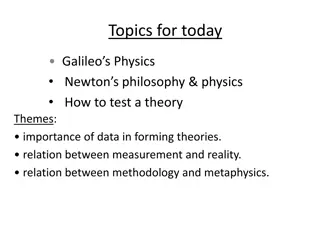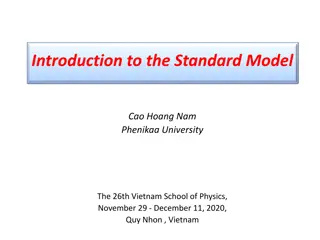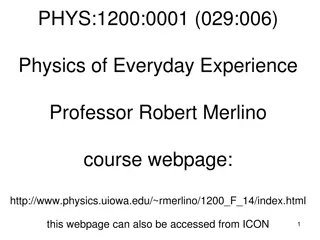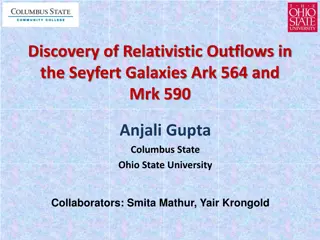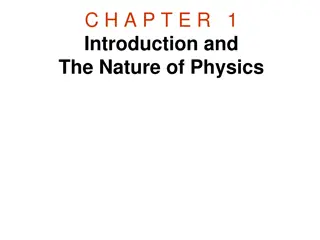Understanding Relativistic Concepts in Physics
Explore the fascinating world of relativity in physics through topics like acceleration transformation, conservation of momentum, momentum, relativistic kinetic energy, and more. Dive into examples involving high-speed probes, total energy conservation, and cosmic-ray-produced muons to grasp the impact of relativistic effects on various physical phenomena.
Download Presentation

Please find below an Image/Link to download the presentation.
The content on the website is provided AS IS for your information and personal use only. It may not be sold, licensed, or shared on other websites without obtaining consent from the author. Download presentation by click this link. If you encounter any issues during the download, it is possible that the publisher has removed the file from their server.
E N D
Presentation Transcript
Chapter 2 Relativity 2
Acceleration transformation ?? ? 1 ??? ? ?= ?2 ?? ?? ? ?= ? = ? ? ?? 3 ?31 ??? ? ?= ? 1 ??? ?2 ? = ? ? ? ?2? ?2 ?? ? ?= ? 1 ??? ?2 ? = ? ???
Conservation of momentum p is conserved in collisions p approaches mu as u/c approaches zero. = ?0 1 ?2 ???=? ?? ?2 ? Momentum Conservation: ? ?0?0+ ? ? ???= ? ?0?0 ? ? ??? ? ? ? ?0 = ?0 1 = ??? 1 ?2 ?2 ? 0 ? ?0 1 ?2 ? ? = ? ? = 1 ?2 ?2 ?2
Momentum ? 1 ? = ? ? ? = ? = ??? ? = 1 ?2 1 ?2 ?2 ?2
Example A high-speed interplanetary probe with a rest mass m = 50,000 kg has been sent toward Pluto at a speed u = 0.8 c. What is its momentum as measured by Mission Control on Earth? If, preparatory to landing on Pluto, the probe s speed is reduced to 0.4 c, by how much does its momentum change?
Relativistic Kinetic Energy Total energy E of any isolated system is conserved E will approach the classical value when u/c approaches zero ? =? ? ??=? ??? Force: ?? Kinetic Energy = Work done by the total force from rest. (1D) ? ? ??= ??? = ?? ??? ?=0 ?=0 ??= ???2 ??2
u/c approaches to zero (Energy) ??2 ??= ???2 ??2= ??2 1 ?2 ?2 ?? 1 2??2 Binomial Expansion (or Taylor expansion) gives 1/2 1 ?2 ?2 ?2+ = 1 +1 ?2 2
Relativistic Total Energy ??= ???2 ??2 u dependent u independent ??2is defined as rest energy Kinetic energy is the amount of energy equals to the work done by the force which change from ??2 to ???2 ??????= ??+ ??2= ???2
Example In Chapter 1, muons produced as secondary particles by cosmic rays were used to illustrate both the relativistic length contraction and time dilation resulting from their high speed relative to observers on Earth. That speed is about 0.998 c. If the rest energy of a muon is 105.7 MeV, what will observers on Earth measure for the total energy of a cosmic-ray-produced muon? What will they measure for its mass as it moves relative to them?
List of rest masses of some particles Electron (positron): 0.5110 MeV Proton: 938.272 MeV Neutron: 939.565 MeV Muon: 105.7 MeV See table 2-1 on page 83 for more.
Lorentz Transformation of E and p ? ?= ? ?? ?? ? ?= ?? 1 ?2 ? = 1 ?2 ? ?= ?? ?2 ? = ? ? ??? Attention! ? = ??? 1 ? = 1 ?2 ?2 ??????= ???2
Example Suppose a micrometeorite of rest mass 10 9 kg moves past Earth at a speed of 0.01 c. What values will be measured for the energy and momentum of the particle by an observer in a system S moving relative to Earth at 0.5 c in the same direction as the micrometeorite?
Mass and Binding Energy A system with two particles bounded together with certain binding energy. Everything is at rest. ??????= ???2= ??2 One particle m ??????= 2??2 Two separate particles m m ??????= ??2= ??+ 2??2 Two bound particles m m The mass of a bound system is less than that of the separated particles by ?? ?2, where ?? is the binding energy.
Example The binding energy of the hydrogen atom (the energy needed to remove the electron from the atom) is 13.6 eV. How much mass is lost when an electron and a proton form a hydrogen atom?
Invariant Mass ? = ? ? ?? Recall ? = ? ?2= ? ?2 ?2+ ?2+ ?2 Invariant spacetime interval ? = ? ? = ? ? ? ?2? ? ?= ? ?? ?? ?2 ? ?= ?? ? ?= ?? ? = ? ? ??? ? = ??? ??????= ???2 ??2 2= ?2 ??2
Example A particular object is observed to move through the laboratory at high speed. Its total energy and the components of its momentum are measured by lab workers to be (in SI unit) ? = 4.5 1017?, ??= 3.8 108?? ?/?, ??= 3.0 108?? ?/?, and ??= 3.0 108?? ?/?. What is the object s rest mass?
System mass The rest mass of the system: 10 kg The total momentum of the system: 0 For the same system, what rest mass of an observer in S , which moves relative to S at ?=0.6, measures?
Massless particle ??2 2= ?2 ??2 ? = ?? For m = 0 Remember that the rest energy of a system of particles is not the sum of the rest energies of the individual particles if they move relative to one another. This applied to photons too! Suppose two photons, one with energy 5 MeV and second with energy 2 MeV, approach each other along the x axis. What is the rest energy of this system?
Creation and Annihilation of Particles Energy Mass positron What is the minimum energy of the photon needed for the following to happen?
Example What is the minimum or threshold energy that a photon must have in order to produce an electron-positron pair? Hint: the photon must hit something. Hint #2, in the minimum case, the created electron and positron carries no kinetic energy (at rest).
General Relativity Einstein s third postulate: A homogeneous gravitational field is completely equivalent to a uniformly accelerated reference frame.
Deflection of starlight Gravitational lens Confirmed by Arthur Eddington in 1919 during total solar eclipse Simulated gravitational lensing (black hole going past a background galaxy).
Gravitational lens Simulated gravitational lensing (Interstellar (movie)).
LIGO (Laser Interferometer Gravitational- Wave Observatory) LIGO, Livingston, LA
Gravitational Wave Detected Based on the details of the signal detected, the LIGO team estimates that the event that generated the gravitational waves occurred 1.3 billion years ago. That's when two black holes, one 29 times the mass of the Sun, the second 36 times, spiraled into each other. When the collision took place, the equivalent of three times the mass of the Sun was converted directly to energy and released in the form of gravitational waves. For a brief fraction of a second, this single event produced more power than the entire rest of the visible Universe combined. "This detection is the beginning of a new era: the field of gravitational wave astronomy is now a reality," said Gabriela Gonz lez of Louisiana State University. Black hole expert Kip Thorne stated, "With this new discovery, we humans are embarking on a marvelous new quest: the quest to explore the warped side of the Universe objects and phenomena that are made from warped spacetime." To provide more precision to that astronomy, the LIGO collaboration will be integrating with the European Virgo detector, which is based on a similar approach. And negotiations are under way to build a LIGO-like detector in India. With four in operation, we'll someday be able to say something more than "somewhere in the Southern Hemisphere."
